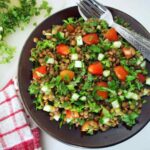Imagine vibrant rice bowls bursting with color and flavor, each a testament to the season’s freshest produce. These aren’t your average takeout containers; these are carefully crafted culinary creations, showcasing the versatility of flexitarian eating. From the satisfying crunch of perfectly roasted vegetables to the comforting warmth of protein-packed lentils or the delightful tang of a homemade citrus vinaigrette, each bowl is a journey for the senses. Prepare to discover the art of quick, healthy, and incredibly delicious flexitarian meals.
This guide dives deep into the world of quick flexitarian rice bowls, offering three distinct recipes featuring diverse protein sources – tofu, beans, and lentils – each with its unique nutritional profile and visual appeal. We’ll walk you through ingredient selection, efficient preparation techniques, and step-by-step cooking instructions for a chicken and vegetable bowl. Plus, we’ll explore three distinct sauce recipes to elevate your culinary game and provide tips for stunning presentation, ensuring your creations are as Instagram-worthy as they are delicious.
Fresh Ingredient Sourcing and Preparation
Crafting vibrant and flavorful flexitarian rice bowls begins with selecting the highest-quality, freshest ingredients. Prioritizing seasonal produce not only enhances the taste and nutritional value but also supports sustainable farming practices and reduces your environmental impact. Efficient preparation techniques will also save you valuable time in the kitchen.
The key to delicious and healthy flexitarian rice bowls lies in the careful selection and preparation of fresh ingredients. Choosing seasonal produce ensures peak flavor and nutritional content, while sustainable sourcing supports responsible agriculture. Efficient preparation techniques, such as batch cooking and smart chopping methods, can significantly reduce cooking time. Finally, proper storage prolongs the life of your ingredients, minimizing waste and maximizing flavor.
Selecting Fresh Seasonal Produce
Prioritizing seasonal produce guarantees the most flavorful and nutritious ingredients for your rice bowls. Seasonal fruits and vegetables are at their peak ripeness, boasting intense flavors and optimal nutrient density. Moreover, choosing seasonal produce often means supporting local farmers and reducing the environmental impact associated with long-distance transportation.
- Summer: Think vibrant tomatoes bursting with sweetness, juicy bell peppers in a rainbow of colors, and crisp cucumbers ideal for adding refreshing crunch. Look for locally grown corn on the cob and sweet summer squash.
- Autumn: Embrace the hearty flavors of butternut squash, pumpkin, and Brussels sprouts. Apples and pears offer a sweet counterpoint, while kale and other leafy greens provide a nutritious base.
- Winter: Root vegetables like carrots, parsnips, and sweet potatoes add earthy sweetness. Citrus fruits like oranges and grapefruits offer a refreshing burst of vitamin C. Consider hearty greens like spinach and Swiss chard.
- Spring: Celebrate the arrival of fresh asparagus, peas, and vibrant green beans. Radishes and spring onions add a delightful peppery bite. Look for leafy greens like arugula and spinach.
Efficient Ingredient Preparation Techniques
Efficient preparation is crucial for creating quick and easy flexitarian rice bowls. Strategic chopping, smart cooking methods, and proper protein preparation can significantly reduce overall cooking time without compromising flavor or quality. Time-saving strategies include prepping ingredients in advance or utilizing pre-cut vegetables when possible, while maintaining focus on preserving nutrient content.
- Chopping Vegetables: Use sharp knives and consistent chopping techniques to ensure even cooking. Consider batch chopping vegetables for the week to save time on busy weeknights. For example, chop a large batch of onions, peppers, and carrots on Sunday to use throughout the week.
- Cooking Grains: Brown rice, quinoa, and other grains can be cooked in large batches and stored in the refrigerator for several days. This allows for quick assembly of your rice bowls throughout the week. Consider using a rice cooker for hands-off cooking.
- Preparing Protein Sources: Roast or grill a large batch of chicken or tofu at the beginning of the week. Store it in airtight containers in the refrigerator for easy addition to your bowls. Pre-cooked beans from cans are a convenient and quick protein option.
Proper Storage of Leftover Ingredients
Proper storage is essential for maintaining the freshness and quality of your ingredients, reducing food waste, and ensuring the safety of your food. Different ingredients require different storage methods to maintain their optimal quality and prevent spoilage. Utilizing airtight containers, proper refrigeration temperatures, and appropriate freezing techniques are crucial.
- Refrigeration: Store most chopped vegetables and cooked grains in airtight containers in the refrigerator for up to 3-5 days. Cooked protein should also be stored in airtight containers.
- Freezing: Freeze leftover cooked grains, vegetables, and protein in freezer-safe containers or bags for longer storage (up to 3 months). Freezing helps to preserve the nutritional value and quality of your ingredients.
- Proper Organization: Organize your refrigerator to ensure easy access to ingredients and to prevent items from getting lost or forgotten. Use clear containers to easily identify the contents.
Step-by-Step Cooking

This recipe details the creation of a vibrant and flavorful chicken and vegetable rice bowl, perfect for a quick and healthy weeknight meal. The steps are designed to be easily followed, even by beginner cooks, resulting in a satisfying and visually appealing dish. Each step builds upon the previous one, culminating in a complete and delicious meal.
Chicken and Vegetable Rice Bowl Recipe
This section provides a detailed, step-by-step guide for preparing a chicken and vegetable rice bowl. The recipe emphasizes fresh ingredients and quick cooking times, making it ideal for busy individuals.
- Prepare the Rice: Rinse one cup of long-grain rice under cold water until the water runs clear. Combine the rinsed rice with two cups of water in a saucepan. Bring to a boil, then reduce heat to low, cover, and simmer for 15-20 minutes, or until all the water is absorbed and the rice is tender. Fluff with a fork and set aside.
- Cook the Chicken: Cut one boneless, skinless chicken breast into bite-sized pieces. Heat one tablespoon of olive oil in a large skillet over medium-high heat. Add the chicken and cook for 5-7 minutes, or until cooked through and browned. Season with salt and pepper to taste.
- Sauté the Vegetables: While the chicken cooks, prepare your vegetables. Chop one bell pepper (any color), half a red onion, and one cup of broccoli florets. Add the vegetables to the skillet with the cooked chicken. Stir in one tablespoon of soy sauce and continue cooking for another 5-7 minutes, or until the vegetables are tender-crisp.
- Assemble the Bowls: Divide the cooked rice evenly among two bowls. Top with the chicken and vegetable mixture. For added flavor and visual appeal, consider garnishing with chopped fresh cilantro, a squeeze of lime juice, and a sprinkle of sesame seeds.
Troubleshooting Common Issues
This section addresses potential problems that may arise during the cooking process and offers solutions to ensure a successful outcome.
- Overcooked Rice: If your rice is overcooked and mushy, it’s likely due to using too much water or cooking it for too long. Next time, carefully measure the water and rice ratio and monitor the cooking time closely. Slightly undercooked rice is preferable to overcooked rice, as it will continue to cook with residual heat.
- Burnt Vegetables: Burnt vegetables are usually a result of too high heat or insufficient stirring. Ensure the heat is at a medium level, and stir frequently to prevent sticking and burning. If vegetables start to brown too quickly, reduce the heat immediately.
Creating quick flexitarian rice bowls is more than just assembling ingredients; it’s about crafting a mindful and delicious meal that nourishes your body and soul. With the right techniques and a touch of creativity, you can transform simple ingredients into vibrant, flavorful masterpieces. From the satisfying textures to the explosion of flavors, each bowl tells a story – a story of fresh ingredients, healthy choices, and the joy of creating something truly special. So, gather your ingredients, embrace the versatility of flexitarian cooking, and embark on a culinary adventure that will leave you feeling energized and satisfied.
Frequently Asked Questions
Can I make these rice bowls ahead of time?
Yes! Prepare the components (rice, protein, vegetables) separately and store them in airtight containers in the refrigerator. Assemble the bowls just before serving for optimal freshness and texture.
What are some good substitutes for the protein sources?
You can easily substitute the suggested proteins with others like chickpeas, quinoa, black beans, or even grilled shrimp or fish, depending on your dietary preferences.
How can I make these bowls more spicy?
Add a pinch of chili flakes or a dash of your favorite hot sauce to the rice or sauce for an extra kick. You can also incorporate spicy vegetables like jalapeños or serrano peppers.
Are these rice bowls suitable for meal prepping?
Absolutely! These bowls are perfect for meal prepping. Prepare the components in advance and assemble them throughout the week for quick and healthy lunches or dinners.


